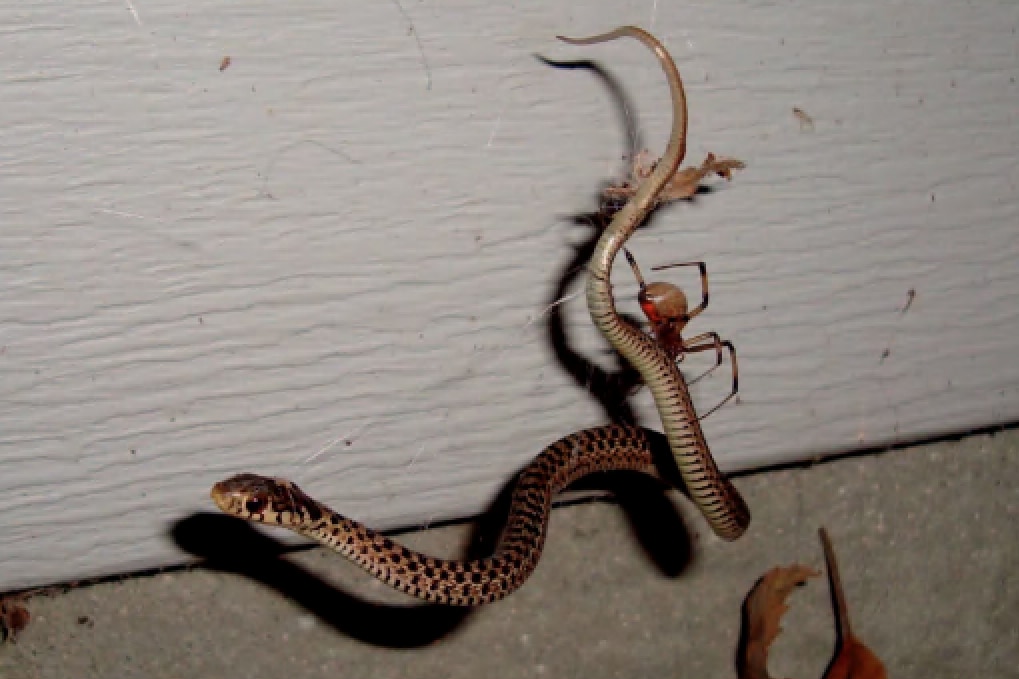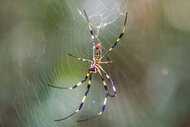Create a free profile to get unlimited access to exclusive videos, sweepstakes, and more!
Spiders that eat snakes up to hundreds of times their size are the real-life Spider-Man vs. the Lizard

There are battles between arachnid and reptile that would warp Marvel canon, because sometimes, the spider is the villain.
Spiders that are supervillains really exist, because at least 30 species in the wild (and 11 in captivity) are now known to be able to take down snakes, and some are monster snakes, or at least monstrous compared to them. Their venom is that lethal. Some weave inescapable webs while others prefer to hunt their prey until it can no longer slither away, and a serpentine meal can last several days, and 86 species of snake are on the menu. It’s the ultimate battle of the creepy crawlies.
Snakes and other vertebrates are usually supplementary food for spiders. That still doesn’t stop the eight-legged predators from catching one when they can, as biologist Martin Nyffeler of the University of Basel in Switzerland found out. He recently led as tudy published in Journal of Arachnology
So why did some spiders evolve venom targeted at vertebrates when they eat mostly insects? Think predators, not prey.
“The toxin produced by highly toxic black widow spiders has developed as a defense against predators," Nyffeler told SYFY WIRE. "Spiders of this type are vulnerable to predation by many animals, including insectivorous mammals, birds, frogs, lizards, and even some snakes. It is assumed that the venom has become highly toxic as a result of coevoltion between the spiders and thier enemies.”
Spiders may use vertebrates as a supplementary food source, so more food available for them when insects are in short supply, and they can therefore survive.
Spider-Man is capable of so many astounding feats for a reason. Arachnids often have super strength they use to their advantage. Now imagine him going evil and taking a bite out of Batman, because they can eat things as large as bats and frogs. Even the Lizard would creep into the shadows if that happened. Snakes can get caught in spiderwebs like the unfortunate one above. A spider will then inject the snake with venom and suck out its innards just like it does with insects. Spiders in the widow family, including the black widow—the namesake of another Avenger—eat half the snakes that end up as arachnid kills.
You don’t mess with widow spiders even if you do have fangs. The venom of these creatures is a deadly neurotoxin that can go up against a much larger snake. This toxin, known as α-Latrotoxin, attacks the nervous system by screwing up neurons and the release of neurotransmitters. The venom of the black widow and the northern widow somehow evolved to paralyze vertebrates more than that of any other spider. About a fifth of snakes that end up as a spider’s dinner are the victims of tarantulas and orb weavers. Orb weavers like funnel-webs and recluse spiders (whose poison can be fatal to humans) create orb-like webs that can conveniently trap an unsuspecting snake.
"I was suprpised by the enormous extent of this type of feeding behavior occurring in spiders, both geographically and taxonomically," said Nyffeler. "This was unexpected. I was also surpsied that so many spider groups are capable of killling and eating snakes, and so many snake species are occasionally killed by spiders. That certain spiders can kill snakes over three feet long, and also some of the deadliest snakes in the world, was another surprise. All of this was uknown before."
What spider could possibly be brazen enough to go up against a snake that appears as if it could swallow the arachnid whole? Try a tarantula.
Tarantulas weave no web, but prefer to stalk snakes on all eight legs. The power of their jaws and neurotoxic venom can overwhelm snakes that go from predator to prey in the time it takes for them to succumb to a bite. No wonder some species of tarantula are such experts at catching and eating snakes, and mostly snakes. A Brazilian tarantula in a lab setting was observed gripping a snake’s head in its jaws, which held on despite every useless effort the snake made to escape. It only took a minute or so for the snake to go limp. The tarantula then crushed the snake’s head in its jaws and slowly fed on the insides. In 24 hours, it had sucked up so much that the corpse was hardly recognizable as a snake anymore.
Arachnids that live in trees will also take advantage of snakes. Snakes that run into orb weaver webs are wrapped in silk before being bitten and envenomated, and left alone for their organs to liquify before the spider sucks them out. Many vipers, cobras, adders and mambas are able to kill a human with just one bite. They feed on vertebrates, which is why it is thought that they are still vulnerable to spiders; they don’t bother with arthropods. The toxicity of their venom proved to be similar to that of the spiders that hide out in their webs and lie in wait for a meal. In fact, nobody has ever seen a venomous snake caught by a spider actually bite the spider.
There is just one question lingering in the aftermath of all these snake kills. Why? Even Nyffeler admits he does not know for sure yet.
"Due to the fact that snake predation by spiders appears to happen only incidentially, I doubt that this had an effect on the
evolution of spiders or snakes," he said, "but there is still a great need for research on this."
Spiders that crave snakes are crawling everywhere except Antarctica. The irony in this is that they don’t always win, because there are many snake species that will snap them up.














